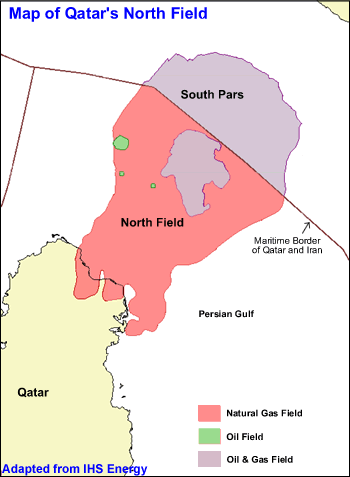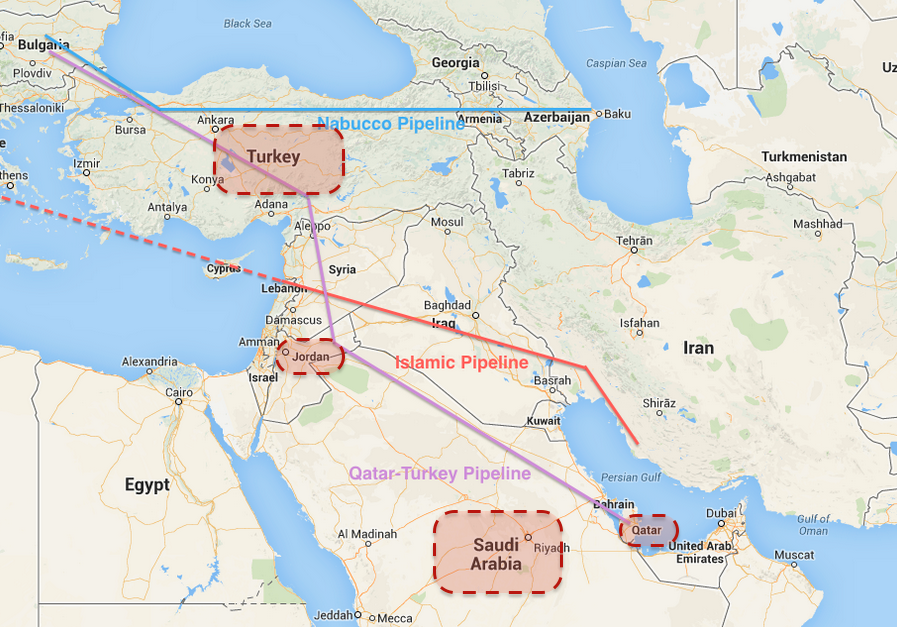Syria’s fossil fuel resources are dwindling fast, making that country an unattractive place to fight a war over crude oil supplies. Yet, a war is being fought over the future of Syria, and a side effect of that war is the huge refugee crisis in Europe. Earlier I’ve made the case that ISIS (one of the factions in the war over Syria) is an accidental creation of America’s disastrous policies in Iraq. Those policies enraged zillions of people in the Middle East against the U.S. and the West, providing ground troops for ISIS. I’ve also made the case that the US and EU were forced into meddling with Iraq and the rest of the Middle East in order to control access to middle eastern crude oil resources.

“South Pars” by US Energy Information Administration – http://www.eia.doe.gov/cabs/Qatar/NaturalGas.html. Licensed under Public Domain via Commons – https://commons.wikimedia.org/wiki/File:South_Pars.gif#/media/File:South_Pars.gif
However, there is another angle to the conflict in Syria — A disagreement over routing of natural gas pipelines from a huge natural gas reservoir in the Persian Gulf. The South Pars / North Dome Field is situated between Qatar and Iran, is split between the two countries, and is thought to be the world’s biggest conventional hydrocarbon accumulation. Because the field is split between two diametrically opposed factions in the Middle East (Shia in Iran, Sunni in Qatar), there are two diametrically opposed routes for bringing that natural gas to market in Europe.
Both those routes go through Syria, and therefore the battle is over which faction is to be in control of supplying the largest single concentration of natural gas in the world to Europe.
Before we get into that, I want to back up and review the geopolitical situation.
Europe doesn’t have much domestic fossil fuel resources. While we hear all kinds of good things about European efforts to adopt wind power and solar power, fact is that Europe (like everywhere) is highly dependent on fossil fuels. Further, Europe has to turn to fossil fuel sources outside of Europe.
The big worry is that because Russia has huge huge huge reserves, primarily natural gas, that Russia will become the dominant natural gas supplier to Europe. It’s expected that result will not work well for Europe because Russian attitudes will be to bleed Europe dry. Therefore American foreign policy includes a stance that Europe’s Energy Security is in the National Interest of the United States, meaning that the U.S.A. is willing to go to war to protect Europe.
To that end the US and EU have been working on many angles to secure non-Russian fossil fuel resources for European use. The coup in Libya may have been staged to gain access to Libya’s oil fields. The Ukraine revolution last year may have been staged in part because of frackable shale fields that could possibly be a natural gas resource for Europe. Last year as the EU-US-Russia tensions built up following the Ukraine revolution, Iran offered its natural gas resources as an alternative to Russia’s![]() , as a way to escape sanctions. Coincidentally such a deal with Iran has been made, and is currently wending its way through Congress. Officials in both US and EU have studied all the potential non-Russian natural gas sources for Europe.
, as a way to escape sanctions. Coincidentally such a deal with Iran has been made, and is currently wending its way through Congress. Officials in both US and EU have studied all the potential non-Russian natural gas sources for Europe.
Now we can get back to the huge natural gas resource in the Persian Gulf.
The question is – put yourself in the shoes of Qatar and Iran, and ask “How do I get this natural gas to market?” The best way to transport natural gas is via pipeline. The likely route for such a pipeline happens to go through Syria, but the Qatar faction wants one route and the Iran faction wants another. The routing for these two pipelines happens to split along Shia/Sunni lines, with the Iran-Iraq-Syria route (Wikipedia![]() ) going through Shia dominated regions and the other going through Sunni dominated regions (Wikipedia
) going through Shia dominated regions and the other going through Sunni dominated regions (Wikipedia![]() ).
).
This map comes from a nice article on ZeroHedge about an anti-ISIS coalition between the US, Turkey, Saudi Arabia and Qatar![]() . The same map appeared in an article on MintPress about the refugee crisis, claiming the real cause of that crisis is the need to run one or the other of these pipelines through Syria
. The same map appeared in an article on MintPress about the refugee crisis, claiming the real cause of that crisis is the need to run one or the other of these pipelines through Syria![]() . Therefore Western powers had to topple Syria’s government in order to get one that’s agreeable to running these pipelines.
. Therefore Western powers had to topple Syria’s government in order to get one that’s agreeable to running these pipelines.
A 2013 report in the Guardian![]() — back when the US staged a stink over chemical weapons in Syria — said the chemical weapons threat was a ruse, and that the real purpose was to support oil interests.
— back when the US staged a stink over chemical weapons in Syria — said the chemical weapons threat was a ruse, and that the real purpose was to support oil interests.
“Assad refused to sign
a proposed agreement with Qatar and Turkey that would run a pipeline from the latter’s North field
, contiguous with Iran’s South Pars field, through Saudi Arabia, Jordan, Syria and on to Turkey, with a view to supply European markets – albeit crucially bypassing Russia. Assad’s rationale was ‘to protect the interests of [his] Russian ally, which is Europe’s top supplier of natural gas.’”
Also back in 2013, Dmitry Minin wrote a piece for the Strategic Culture Foundation, the Geopolitics of Gas and the Syrian Crisis![]() . He notes that the civil war in Syria began “almost at the same time as the signing of a memorandum in Bushehr on June 25, 2011 regarding the construction of a new Iran-Iraq-Syria gas pipeline.” According to a UPI report from 2011
. He notes that the civil war in Syria began “almost at the same time as the signing of a memorandum in Bushehr on June 25, 2011 regarding the construction of a new Iran-Iraq-Syria gas pipeline.” According to a UPI report from 2011![]() , the Iran-Iraq-Syria pipeline would have bypassed Turkey and been in competition against the Nabucco Pipeline, which was one of the proposals to bring Azerbaijani natural gas to Europe. Pepe Escobar had a similar report
, the Iran-Iraq-Syria pipeline would have bypassed Turkey and been in competition against the Nabucco Pipeline, which was one of the proposals to bring Azerbaijani natural gas to Europe. Pepe Escobar had a similar report![]() in that time-frame that’s also an interesting read.
in that time-frame that’s also an interesting read.
Syria and Iran, as clients of Russia, would not want to support Nabucco, or any other pipeline for Azerbaijani gas, because of the harm such a pipeline would do to Russia’s interests.
Sunni’s saw this pipeline as a «Shiite pipeline from Shiite Iran through the territory of Iraq with its Shiite majority and into the territory of Shiite-friendly Alawite Asad». (The Alawite’s being another Islamic faction that some think is friendly to Shia Islam)
Qatar has about half of this field, and importantly is a Sunni country. Its allies designed another route that primarily went through Sunni territories, but had to cross Syria. Syria has been friendly with both Iran and Russia, and the Assad’s are supposedly Shia-friendly. According to Dmitry Minin, the map of fighting in Syria in 2013 happens to coincide with the route necessary for a pipeline to Turkey.
The result of all this is this pairing of alliances:
- Turkey, Qatar, Saudi Arabia, U.S., Britain and France
- Syria, Iran and Russia.
Except that the U.S. just made a deal with Iran that would lift sanctions on that country in exchange for promises regarding nuclear power development. Could that deal also affect the alliances just outlined?
In any case, for the Qatar-Turkey faction to be in control of shipping this gas to Europe, they had to change the government in Syria. Hence, an engineered civil war in Syria. With the advent of ISIS, that war has blown way out of control.
According to Minin, Qatar had signed a pact with the Muslim Brotherhood to support their international expansion, leading to Muslim Brotherhood governments in Jordan and Syria.
In summary – all this says the Middle East is full of feuding factions. They see Syria’s territory as a useful route for a natural gas pipeline. The route for that pipeline is the subject of a multi-dimensional war over the future of Syria. The prize goes to whoever is in control of the channel via which natural gas in the South Pars / North Dome Field makes it to Europe.
- Is there enough Grid Capacity for Hydrogen Fuel Cell or Battery Electric cars? - April 23, 2023
- Is Tesla finagling to grab federal NEVI dollars for Supercharger network? - November 15, 2022
- Tesla announces the North American Charging Standard charging connector - November 11, 2022
- Lightning Motorcycles adopts Silicon battery, 5 minute charge time gives 135 miles range - November 9, 2022
- Tesla Autopilot under US Dept of Transportation scrutiny - June 13, 2022
- Spectacular CNG bus fire misrepresented as EV bus fire - April 21, 2022
- Moldova, Ukraine, Georgia, Russia, and the European Energy Crisis - December 21, 2021
- Li-Bridge leading the USA across lithium battery chasm - October 29, 2021
- USA increasing domestic lithium battery research and manufacturing - October 28, 2021
- Electrify America building USA/Canada-wide EV charging network - October 27, 2021






















Pingback: Syria in oil war mess as Russia and US fight to support opposite sides of civil war | The Long Tail Pipe
Pingback: Turkey’s attempted coup, their critical role for Europe/EU/NATO, and non-Russian natural gas | The Long Tail Pipe